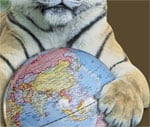Asia’s most dynamic economies are amassing huge cash fortunes that they can then wield to increase their power around the world. Will 2008 be the year when we t ruly see the balance of global power shift to the East?

But it may not take that long for economic power to shift toward the East. Some observers suggest that China and India are moving toward their long-term potential faster than anticipated and that a substantial shift in the balance of economic power to the East is already under way. “There has been a major shift toward emerging markets, particularly in Asia, which is growing faster than most economies,” says Nicholas Kwan, regional head of research for Asia at Standard Chartered Bank. “In that sense you can argue [that power has shifted] in relative terms toward China and other parts of Asia. And increasingly they are taking a bigger share of world GDP.”
In 2006 GDP for the whole of developing Asia grew at 8.3%, the fastest rate of growth since 1995, according to the Asian Development Bank. India’s economy has been growing by more than 8% a year for the past four years, four times the growth rate of the UK and three times that of the US. China has seen annual growth increase from 7% in 1999 to more than 10%. Kwan says a more sophisticated measure of economic power is purchasing power parity, and by that measure the US is still the dominant power, accounting for one-fifth of global GDP. He estimates that China and other parts of Asia, excluding Japan, account for somewhere between 25% and 30% of world GDP.
Michala Marcussen, head of economic strategy and research at Société Générale Asset Management (SGAM), explains that economic power is building in Asia as investor sentiment toward emerging markets undergoes a fundamental shift. “Go back 20 years, and emerging markets were something most UK pension funds would not have considered investing in,” she says. “The way people look at these markets has changed significantly.”
But while Asia’s star is in the ascendant, Marcussen says the US still remains the “economic superpower” because of its military supremacy and the sophistication and strength of its financial markets. “China is not going to surpass the US by that measure anytime soon,” she says. “China is an exciting story, but we have to be careful not to get ahead of ourselves.” According to McKinsey, in the next decade Asia is poised to rival and potentially surpass Western Europe as a pool of financial-services revenue. It estimates that from 2005 to 2015, Asia could contribute more than 27% of projected global growth in financial services, up from its 13% contribution between 2000 and 2005. McKinsey says potentially Asia could achieve close to 30% of global revenue pools, depending on consumption patterns among the projected 800 million new middle-class individuals and on the globalization of Asian companies.
Growth Delinks from Exports
When it comes to industrial output, a clear shift away from the West to the East is already taking place. McKinsey predicts that by 2015 there will be a significant shift toward Asia in steel, chemicals and computers, with more than 70% of computer output coming from Asia. Historically, the fortunes of many Asian economies have been tightly linked to the US economy. But the old adage that “when America coughs, the rest of the world sneezes” is losing its relevance in Asia.
Contrary to popular belief, Jonathan Anderson, an economist with UBS, maintains that China is not as exposed to the US as some may think. “We estimate the ‘true’ export share of production-side GDP at 9%—orders of magnitude less than in China’s smaller neighbors—and historically even the largest negative export shocks only have a moderate impact on domestic growth,” he stated in a recent economic analysis of China. UBS expects real export growth for China to fall to 15% or lower in 2008 on the back of US consumer weakness and a slowing global economy.
However, Anderson says that China will remain one of Asia’s fastest-growing exporters, and it will continue to gain market share, particularly in low-end and mid-level processing and assembly functions. “We don’t expect a global downturn to derail China’s current buoyant momentum,” he says. “In our view, it would take a very large external shock indeed to have a significant impact on growth at present.”
As Asian economies become less dependent on trade and more reliant on internal investment for growth, the region is becoming known not only for the products it exports to the rest of the world but also for its own consumption of resources, which is giving rise to a new, more powerful consumer class. According to UBS, one of the biggest structural trends of the past five years is the recovery in Chinese rural incomes and spending, with an associated pickup in retail sales and inland growth, gains it expects will continue over the next half-decade.
McKinsey predicts that, between 2005 and 2015, more than 540 million people in India and almost 270 million in China will emerge as a new class of consumers. “China has the strongest potential consumer market in the world,” observes Karl Alomar, co-founder and CEO of China Export Finance. “The middle class is becoming increasingly wealthy, and there are new millionaires among manufacturers and exporters.” According to CapGemini and Merrill Lynch’s 2006 World Wealth Report, the highest growth in terms of the population of high-net-worth individuals (HNWI) in 2005 was in South Korea (21.3%) and India (19.3%). HNWI financial wealth in Asia is expected to grow at an annual rate of 6.7%, outstripping the global rate of 6%.
On the consumption side, though, there are major differences between India and China. According to McKinsey, in 2005 the share of private spending of GDP was 62% in India compared to 39% in China. The much lower rate in China is attributed to high domestic savings rates and a lower proportion of GDP going to households as a result of lower wages and slower job creation.
 |
|
Alomar: China has the strongest potential consumer market in the world. |
But while per capita consumption is still lower in Asia than, say, the US, the potential for future growth is mind-boggling. “The most impressive thing about [China and India] and the thing that unites them is population,” says David Smith, economics editor at the UK Sunday Times, in his latest book, The Dragon and the Elephant. China and India have a combined population of 2.4 billion people, almost half the world’s population. Studies suggest that in quantitative terms the emergence of India and China is the “biggest shock” the world economy has had to absorb. A bountiful supply of cheap and skilled labor is why China has become the workshop of the world and India the global back office, and other Asian countries hope to emulate that success. “In areas like manufacturing, the shift toward Asia has already occurred,” says Dominic Barton, chairman of McKinsey Asia. “In the next 20 years the shift will be felt in many other areas.”
Even in the face of emerging competitive markets, rising costs and quality concerns, Alomar says China’s key competitive advantage remains its vast labor pool, which will continue to ensure its dominance in manufacturing. And although labor costs in India and China may be rising, Kwan of Standard Chartered says that it will be years if not decades before they are on a par with the West.
As demand for goods made in Asia grows and the purchasing power of Asian consumers increases, the region is producing its own corporate titans. McKinsey points to companies such as China Mobile, whose market cap increased from $65.5 billion in 2000 to $103.7 billion by May 2006. Even more remarkable has been the rise of Indian corporations such as Tata Motors, whose market cap increased from half a billion US dollars in 2000 to $6.5 billion in May 2006. India’s ICICI Bank has seen its market cap go from just over half a billion US dollars in 2000 to $10.3 billion by May 2006.
In their efforts to become global brand names, well-capitalized Asian companies are also asserting themselves on the global stage. High-profile examples include Tata Steel’s acquisition of Anglo-Dutch steelmaker Corus Group for $12.2 billion and Chinese mining companies’ rumored pursuit of Anglo-Australian giant Rio Tinto. Barton says that Chinese and Korean companies are also investing in other parts of Asia, which will facilitate the development of more-liquid local capital markets.
 |
|
Barton: Trade protectionist measures are unlikely to bring China to its knees; it is more resilient and independent |
Asia Faces Backlash
Barton says Indian firms are already looking to Chinese construction companies to help them build airports, and Indian software companies are conducting some of their software development in China. Members of the ASEAN group of countries have also fostered higher levels of regional trade and cooperation. “We are seeing a trading bloc emerging [in South East Asia],” says Barton. “I can easily see people sourcing goods or buying goods from within the region.”
Barton adds that new trading paths are being created between India, China and the Middle East, including a revival of the old silk trading route between the Middle East and Asia. According to McKinsey, trade between the Middle East and Asia reached $302 billion in 2005. The biggest growth has been in trade between the Middle East and China, which increased more than tenfold from $6 billion in 1995 to $69 billion in 2006.
Asia Flexes Financial Muscle
The stockpiling of substantial foreign exchange reserves in Asia and the formation of new investment corporations to manage these funds has also increased Asia’s investment power. Asian central bank FX reserves totaled $3.1 trillion at the end of 2006. McKinsey says Asian central banks are examples of what it terms “new financial power brokers,” which also includes hedge funds and private equity firms. According to McKinsey, at the end of 2006 the central banks of China and Japan held $1.1 trillion and $875 billion, respectively, in reserves. Six other of the region’s central banks—Hong Kong, India, Malaysia, Singapore, South Korea and Taiwan—also hold massive FX reserves.
“If you look at FX reserve accumulation in terms of the total stock of foreign assets, China is still way behind the West and does not hold a huge amount of foreign wealth compared to Japan on a per capita basis,” notes Kwan of Standard Chartered. However, he says the growth in reserves within Asia is “phenomenal,” with China adding $300 billion to $400 billion to its reserves every year.
More important, says Barton, “Asia is now a source of capital in its own right.” He adds that this is a major departure from the 1980s and 1990s, when the region borrowed from the West. According to McKinsey, approximately $2 trillion of Asian central bank assets are invested in US-dollar-denominated assets, such as US treasuries. The mix of investments is gradually changing, though, with central banks in China, South Korea and Singapore having announced plans to diversify their assets, which could spread the “liquidity” effect to other asset classes. If some of that money finds its way into Asian investments, it could also help spur development of Asia’s financial markets.
Anderson of UBS plays down the significance of China Investment Corp.’s $3 billion non-voting stake in Blackstone, however. He says that of the initial $200 billion in capital it holds, only $65 billion constitutes “truly investable funds.” However, the rise of these new global power brokers should not be underestimated, particularly as the accumulation of reserves in Asia increases global liquidity, which could lead to “asset price bubbles” and inflationary pressures.
But increasing economic power also has its limitations. Most Western observers agree that if China and India and other Asian economies want to move further up the value chain and develop more broad-based economies, then they need to invest more in intellectual capital and technological know-how.
China also needs to get to grips with its aging population, which raises challenges in terms of health care. “It is the first time a country is getting old before it emerges,” says Marcussen. India and China also face the challenge of growing inequality, she adds. “A large part of the Indian labor force still speaks little English and is poorly educated,” she points out.
So while Marcussen promotes the Asia “decoupling” story, she says it comes with a certain nuance. Barton concedes that Asia’s ascendancy as an economic power will not occur in a straight line. “There will be bumps and bankruptcies, but the rise of Asia as an economic power is inevitable, as it is the most populous region in the world, and it is well-integrated within global supply chains.”
Anita Hawser



